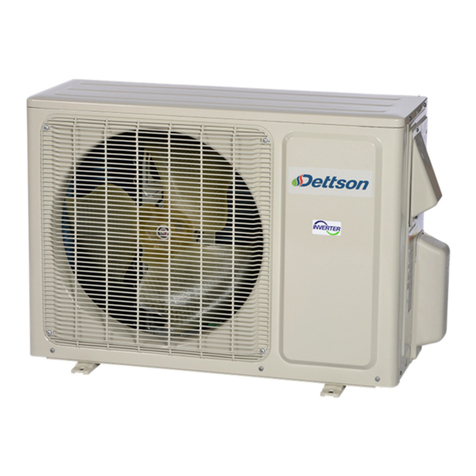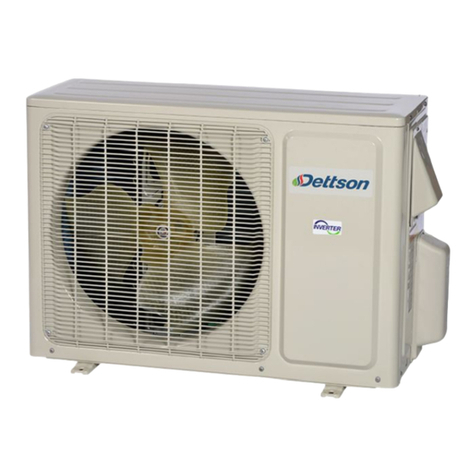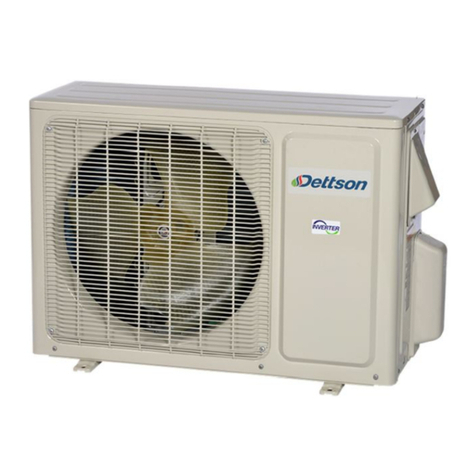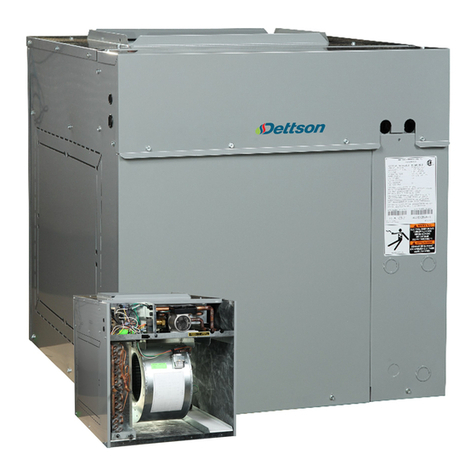
3
TABLE
OF CONTENTS
APPENDIX 1.
............................................................. 1
1-
SAFETY PRECAUTIONS .......................................... 5
1.1-
Warning .................................................................... 5
1.2-
Caution ..................................................................... 5
1.3-
Specifications table................................................... 6
1.4-
Operation Charateristic Curves ................................ 7
1.5-
Capacity variation ratio according to temperature .... 8
1.6-
Noise criteria curve tables ........................................ 9
2-
CONSTRUCTION VIEWS ........................................ 10
3-
REGRIGERANT SYSTEM DIAGRAM ..................... 12
4-
SCHEMATIC DIAGRAMS........................................ 12
4.1-
Electrical diagrams ................................................. 12
4.2-
Printed circuit boards.............................................. 14
5-
FUNCTIONS AND CONTROL OUTDOOR UNIT .... 16
5.1-
Thermostat ............................................................. 16
5.1.1-
Communicating thermostat (R02P030) .......... 16
5.1.2-
Legacy thermostat.......................................... 16
5.2-
Balance point adjustment ....................................... 16
5.3-
Function & control................................................... 16
5.3.1-
09/12K Unit .................................................... 16
5.3.2-
18/24K Unit .................................................... 18
6-
INSTALLATION MANUAL ....................................... 21
6.1-
Notices for installation ............................................ 21
6.2-
Installation site instructions..................................... 21
6.3-
Installation site of outdoor unit ................................ 21
6.4-
Safety precautions for electric appliances .............. 21
6.5-
Grounding............................................................... 21
6.6-
Installation drawing................................................. 22
6.7-
Installation of indoor cooling coil............................. 22
6.7.1-
Multiposition coil............................................. 22
6.7.2-
Multiposition (field conversion) ....................... 24
6.7.3-
Condensate drain........................................... 24
6.8-
Installation of interface card.................................... 24
6.9-
Installation of connection pipe ................................ 25
6.10-
Installation of outdoor unit ...................................... 26
6.10.1-
Electrical wiring .............................................. 26
6.10.2-
Air purging and leakage test .......................... 26
6.10.3-
Outdoor unit condensate drainage ................. 26
6.10.4-
Check after installation and test operation......26
6.10.5-
Operation test .................................................26
7-
TROUBLESHOOTING..............................................27
7.1-
Precautions before performing inspection or repair 31
7.2-
Verification ..............................................................31
7.3-
Malfunction & status codes of the interface card
flashing leds ......................................................................32
7.4-
Malfunction & status codes of the outddor unit
flashing leds ......................................................................33
7.5-
Troubleshooting flow chart ......................................39
7.5.1-
Communication malfunction ...........................39
7.5.2-
Capacity charging malfunction (outdoor unit
malfunction)................................................................40
7.5.3-
IPM protection desynchronizing malfunction;
compressor overcurrent..............................................41
7.5.4-
Anti-high temperature, overload protection.....42
7.5.5-
Failure start up malfunction ............................43
7.5.6-
Compressor synchronism ...............................44
7.5.7-
Overload and discharge malfunction ..............45
7.5.8-
PFC (correction for power factor) malfunction 46
7.5.9-
Communication malfunction ...........................47
8-
REMOVAL PROCEDURE OF OUTDOOR UNIT .....48
9-
COMPONENTS AND REPLACEMENT PARTS......67
9.1-
Exploded vue 9/12k ................................................67
9.2-
Parts list 9/12k ........................................................68
9.3-
Exploded vue 18k ...................................................69
9.4-
Parts list 18K...........................................................70
9.5-
Exploded vue 24k ...................................................71
9.6-
Parts list 24K...........................................................72
APPENDIX 1.
RESISTANCE TABLE OF AMBIENT
TEMPERATURE SENSOR 15 K ...................................73
APPENDIX 2.
RESISTANCE TABLE OF TUBE
TEMPERATURE SENSOR 20 K ...................................74
APPENDIX 3.
RESISTANCE TABLE OF OUTDOOR
DISCHARGE TEMPERATURE SENSOR 50 K ............75
APPENDIX 4.
WARRANTY POLICY ........................76


































